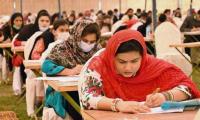KARACHI: The central bank warned on Friday that borrowers’ ability to repay their debts could be put under pressure, raising questions about the banks’ capacity to maintain their asset quality, which could lead to the number of bad loans.
“The assessment of macroeconomic dynamics reveals a number of challenges for the banking sector,” the State Bank of Pakistan (SBP) said in its annual flagship publication, the Financial Stability Review (FSR) for 2022.
“The repayment capacity of borrowers may come under stress, leading to asset quality concerns for the banks. Particularly, the business model of MFBs [microfinance banks] needs a review to improve the performance of this important sector,” it said.
“Also, banks’ earnings from advances and non-interest incomes are likely to moderate due to subdued economic activities and banks’ increased risk aversion towards private sector credit,” it added.
While the prevailing high return on government securities and strong government financing needs can augment banks’ earnings, increased public sector exposure has a number of implications including crowding out of private sector credit and re-pricing/ revaluation risks, among others, it noted.
Moreover, credit demand, especially from the government, will require enhanced efforts for the mobilisation of deposits to meet the liquidity needs of the system. In this regard, there is also a need for the government to diversify its sources of funding and tap alternate sources, including enhancing tax revenues to achieve fiscal consolidation.
The government needs to take appropriate policy measures to improve productivity, export competitiveness, and debt sustainability, according to the SBP.
Dynamics of financial stability are subject to quite uncertain and complex factors; therefore, SBP regularly conducts scenario analysis on a periodic basis to identify the likely path of the banking sector’s soundness indicators over the next two to three years in different assumed hypothetical scenarios.
“The results of the latest macro stress tests suggest that in the face of continued hypothetical stress, the banking sector may experience an increase in non-performing loans,” the review said.
However, the banking sector in general, and the large systemically important banks in particular, are expected to show sufficient resilience to withstand assumed severe macroeconomic shocks. The overall capital adequacy ratio (CAR) of the sector is likely to remain above the minimum regulatory requirement, it noted.
The SBP’S review highlights that a comprehensive supervisory and safety net framework is also in place to preserve the general confidence in banking system and safeguard the soundness of regulated institutions. The SBP’s supervisory framework proactively monitors and assess both firm-specific and system-wide risks to financial stability and takes proactive actions to address these risks.
During the year under review, SBP took a number of measures to further strengthen the framework in line with market conditions and emerging best practices.
Going forward, the dynamics of financial stability would be contingent upon evolving conditions both at international and domestic fronts. The results of the latest macro stress tests suggest that the banking sector, in general, and the large systemically important banks, in particular, are expected to show resilience to withstand assumed severe macroeconomic shocks.
The SBP is, however, cognizant of the prevailing risks. With the toolkit and capabilities at its disposal, SBP stands prepared to take necessary and timely measures to preserve financial stability and support economic growth by ensuring a smooth supply of credit and financial services in the economy.
Pakistan’s economy experienced a turbulent year as the existing economic imbalances were compounded by the unfavourable external environment.
Domestic headwinds, including the twin deficits, high inflation, catastrophic flooding, delay in the completion of IMF programme reviews as well as the global challenges such as fast-paced increase in commodity prices and monetary tightening by major central banks in advanced economies, manifested in the deteriorating macroeconomic conditions.
Nonetheless, financial sector showed resilience against these stresses and posted steady performance. The financial sector’s asset base grew by 18.3 percent in CY2022—mainly supported by the banking sector.
The review notes that the SBP and the government took various policy steps to address widening imbalances, which included further increase in policy rate and macro-prudential policies pertaining to consumer financing and administrative measures to contain external imbalance.
Resultantly, current account deficit improved towards the year end while economic momentum weakened. In this backdrop, the GDP grew only by a meagre 0.29 percent in FY2023.
The banking sector witnessed a strong growth of 19.1 percent in its assets. This expansion was mainly driven by investments while advances decelerated. Since deposits observed notable slowdown, banks’ reliance on borrowings remained substantial. Encouragingly, the credit risk remained contained as gross NPLs ratio lowered to 7.3 percent by end of 2022 from 7.9 percent at end of 2021, while the net NPLs ratio slightly inched up to 0.8 percent from 0.7 percent a year earlier, remaining at one of the lowest levels of last two decades.
Banks’s after-tax earnings improved, primarily due to rise in interest income. As a result, (ROE) improved to 16.9 percent in 2022 from 14.0 percent in last year. The contained delinquencies and higher profitability supported banks’ solvency as CAR stood at 17.0 percent – well above the minimum regulatory requirement of 11.5 percent.
The Islamic banking segment also observed robust growth of 29.6 percent during 2022. The asset quality indicators improved and earnings rebounded from previous year. Microfinance banks, however, remained under stress as the asset quality indicators deteriorated along with after-tax losses, the SBP review stated.
Systems Limited, IT and IT-enabled services provider, hosted US Ambassador to Pakistan Donald Blome on May 3, 2024....
The logo of the Telenor Microfinance Bank . — temenos websiteKARACHI: Telenor Microfinance Bank reported a strong...
Chief Executive TDAP Mr. Zubair Motiwala met with HE Dr. Bakheet Ateeq Al-Remaiti, Consul General of UAE, in Karachi...
A representational image of gold bangles. — AFP/FileKARACHI: Gold prices in the local market dropped by Rs1,400 per...
A person walks by a sign advertising employment at a fast-food restaurant in New York City. — AFP FileWASHINGTON:...
This picture taken on January 30, 2023 shows residents buying vegetable at a market in Karachi. — AFP/FileLAHORE:...







